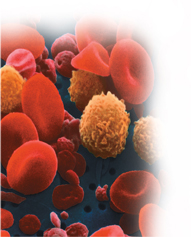33.2 Blood and the Lymphatic System
 What is the function of each component in blood?
What is the function of each component in blood? What is the function of the lymphatic system?
What is the function of the lymphatic system? What are three common circulatory diseases?
What are three common circulatory diseases? What is the connection between cholesterol and circulatory disease?
What is the connection between cholesterol and circulatory disease?
plasma • red blood cell • hemoglobin • white blood cell • platelet • lymph • atherosclerosis
Outline Before you read, make an outline of the major headings in the lesson. As you read, fill in main ideas and supporting details for each heading.
THINK ABOUT IT It When you think about body tissues, you probably picture something with a definite shape, like muscle or skin. But blood is a tissue too—it just happens to be in liquid form! The more you think about blood, the more remarkable its many functions are. In addition to transporting oxygen and fighting disease, it carries substances your body makes and sources of energy such as sugars and fats. In fact, one of the best ways to judge a person's health is—you guessed it—a blood test. How does this unusual tissue perform so many essential functions?
Blood
 What is the function of each component in blood?
What is the function of each component in blood?
You might think that the most important function of blood is to serve as the body's transportation system. But the various components of blood also help regulate body temperature, fight infections, and produce clots that help minimize the loss of body fluids from wounds.
Plasma The human body contains 4 to 6 liters of blood. About 55 percent of total blood volume is a straw-colored fluid called plasma.  Plasma is about 90 percent water and 10 percent dissolved gases, salts, nutrients, enzymes, hormones, waste products, plasma proteins, cholesterol, and other important compounds.
Plasma is about 90 percent water and 10 percent dissolved gases, salts, nutrients, enzymes, hormones, waste products, plasma proteins, cholesterol, and other important compounds.
The water in plasma helps to control body temperature. Plasma proteins consist of three types—albumin, globulins, and fibrinogen. Albumin and globulins transport substances such as fatty acids, hormones, and vitamins. Albumin also plays an important role in regulating osmotic pressure and blood volume. Some globulins fight viral and bacterial infections. Fibrinogen is necessary for blood to clot.
Red Blood Cells The most numerous cells in blood are red blood cells, or erythrocytes (eh RITH roh syts).  The main function of red blood cells is to transport oxygen. They get their crimson color from the iron in hemoglobin, a protein that binds oxygen in the lungs and releases it in capillary networks throughout the body. Then red blood cells transport some carbon dioxide to the lungs.
The main function of red blood cells is to transport oxygen. They get their crimson color from the iron in hemoglobin, a protein that binds oxygen in the lungs and releases it in capillary networks throughout the body. Then red blood cells transport some carbon dioxide to the lungs.
Red blood cells are disks that are thinner in their center than along their edges. They are produced by cells in red bone marrow. As red blood cells mature and fill with hemoglobin, their nuclei and other organelles are forced out. Red blood cells circulate for an average of 120 days before they are destroyed in the liver and spleen.

FIGURE 33–8 Blood Cells The micrograph shows red blood cells (red disks), white blood cells (gold orbs), and platelets (pink fragments) (SEM 1866X).

Table of Contents
- Formulas and Equations
- Applying Formulas and Equations
- Mean, Median, and Mode
- Estimation
- Using Measurements in Calculations
- Effects of Measurement Errors
- Accuracy
- Precision
- Comparing Accuracy and Precision
- Significant Figures
- Calculating With Significant Figures
- Scientific Notation
- Calculating With Scientific Notation
- Dimensional Analysis
- Applying Dimensional Analysis




